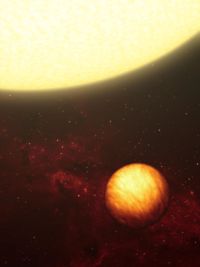Upsilon Andromedae b
2007 Schools Wikipedia Selection. Related subjects: Space (Astronomy)
| Extrasolar planet | Lists of extrasolar planets | |
|---|---|---|
 |
||
| Parent star | ||
| Star | Upsilon Andromedae A | |
| Constellation | Andromeda | |
| Right ascension | (α) | 01h 36m 47.8s |
| Declination | (δ) | +41° 24′ 20″ |
| Spectral type | F8V | |
| Orbital elements | ||
| Semimajor axis | (a) | 0.0595 ± 0.0034 AU |
| Eccentricity | (e) | 0.023 ± 0.018 |
| Orbital period | (P) | 4.617113 ± 0.000082 d |
| Inclination | (i) | ?° |
| Longitude of periastron |
(ω) | 63.4° |
| Time of periastron | (τ) | 2,451,802.64 ± 0.71 JD |
| Physical characteristics | ||
| Mass | (m) | >0.687 ± 0.058 MJ |
| Radius | (r) | ? RJ |
| Density | (ρ) | ? kg/ m3 |
| Temperature | (T) | ~150 to ~1800 K |
| Discovery information | ||
| Discovery date | 1996 | |
| Discoverer(s) | Butler, Marcy et al. | |
| Detection method | Radial velocity | |
| Discovery status | Confirmed | |
| Other designations | ||
|
Upsilon Andromedae Ab, 50 Andromedae b
|
||
Upsilon Andromedae b (occasionally referred to as Upsilon Andromedae Ab to distinguish it from the red dwarf star Upsilon Andromedae B) is an extrasolar planet orbiting the Sun-like star Upsilon Andromedae A every 4.62 days. Discovered in 1996 by Geoffrey Marcy and R. Paul Butler, it was one of the first hot Jupiters to be discovered. Upsilon Andromedae b is the innermost known planet in its planetary system.
Discovery
Like the majority of known extrasolar planets, Upsilon Andromedae b was detected by the variations in its star's radial velocity caused by the planet's gravity. The variations were detected by making sensitive measurements of the Doppler shift of Upsilon Andromedae's spectrum. The planet was announced in 1996, together with 55 Cancri b and the planet orbiting Tau Boötis.
Orbit and mass
Like 51 Pegasi b, the first extrasolar planet discovered around a normal star, Upsilon Andromedae b orbits very close to its star, closer than Mercury does to our Sun. The planet takes 4.617 days to complete an orbit, with a semimajor axis of 0.0595 AU.
A limitation of the radial velocity method used to detect Upsilon Andromedae b is that only a lower limit on the mass can be found. In the case of Upsilon Andromedae b, this lower limit is 68.7% of the mass of Jupiter, though depending on the inclination of the orbit, the true mass may be much greater.
Characteristics
Given the planet's high mass, it is likely that Upsilon Andromedae b is a gas giant with no solid surface. Since the planet has only been detected indirectly, properties such as its radius and composition are unknown. Assuming that the planet is similar to Jupiter in composition and that its environment is close to chemical equilibrium, Upsilon Andromedae b is predicted to have clouds of silicates and iron in its upper atmosphere.
The Spitzer Space Telescope measured the planet temperature, and found that the difference between the two sides of Upsilon Andromedae b of about 1,400 degrees Celsius, ranging from minus 20 to 230 degrees to about 1,400 to 1,650 degrees Celsius.
Upsilon Andromedae b appears to be responsible for increased chromospheric activity on its parent star. Observations suggest that there is a "hot spot" on the star around 169° away from the sub-planetary point. This may be the result of interactions between the magnetic fields of the planet and the star. The mechanism may be similar to that responsible for the activity of RS Canum Venaticorum variable stars, or the interaction between Jupiter and its moon Io.
The planet is unlikely to have large moons, since tidal forces would either eject them from orbit or destroy them on short timescales compared to the age of the system.